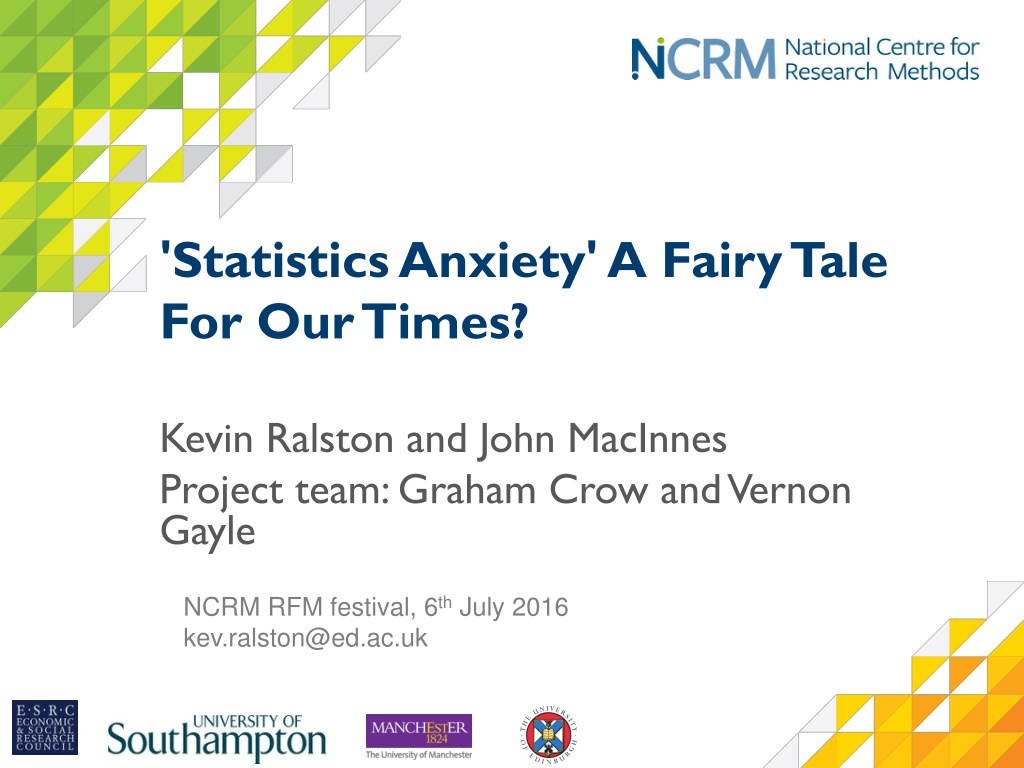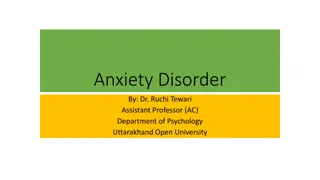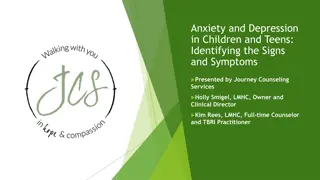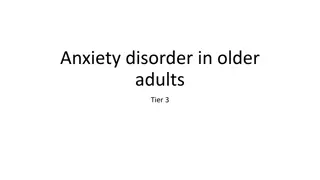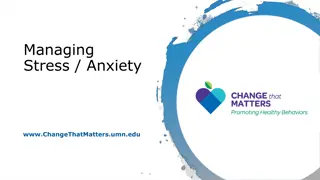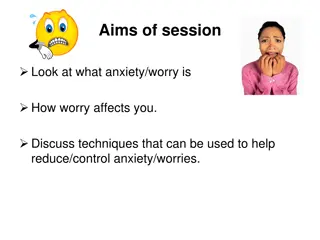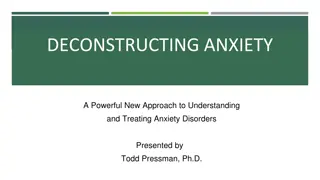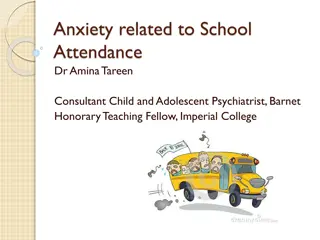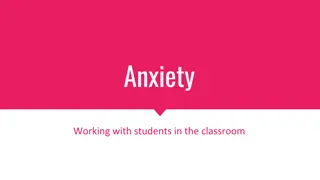Understanding Statistical Anxiety: A Critical Examination
Explore the concept of Statistical Anxiety (SA) and its impact on students encountering statistics, delving into key definitions and research findings. The study discusses primary data collection, literature review on QM pedagogy, and empirical studies, shedding light on the enduring apprehension felt by many when dealing with statistical content.
Download Presentation

Please find below an Image/Link to download the presentation.
The content on the website is provided AS IS for your information and personal use only. It may not be sold, licensed, or shared on other websites without obtaining consent from the author. Download presentation by click this link. If you encounter any issues during the download, it is possible that the publisher has removed the file from their server.
E N D
Presentation Transcript
'Statistics Anxiety' A Fairy Tale For Our Times? Kevin Ralston and John MacInnes Project team: Graham Crow and Vernon Gayle NCRM RFM festival, 6th July 2016 kev.ralston@ed.ac.uk
Study: General Aims QM pedagogy: http://www.ncrm.ac.uk/research/WP6/wp6.php Substantial primary data collection component Teaching Review of evidence What is out there empirically? Practitioner experience of difficulty in teaching students involving maths Views of school level teachers of problems of preparing students for university Learning Influence of Statistical Anxiety Comparisons of different subject areas Researching a number of universities Differences, by gender, age, previous education, type of institution etc Ralston, K.,MacInnes, J. Crow, G. Gayle, V. (Forthcoming) We need to talk about statistical anxiety, NCRM Working Paper Ralston, K.,MacInnes, J. Crow, G. Gayle, V. (2015),Quantitative Methods Pedagogy in Social Science,Methods News, ESRC National Centre for Research Methods Newsletter, Summer 2015 Ralston, K. (2015), Quantitative Methods Pedagogy in Sociology: What have we got to go on? The Detective s Handbook (blog), (accessed 25/11/15).
QM/sociology/social-science literature 3 categories in the relevant literature: 1. High level - Background Agenda setting/ horizon scanning General recommendations for QM pedagogy 2. Different approaches to QM This is how I/we do it E.g. I ve spent 20 years teaching and this is how I do it 3. Empirical Studies, some evidence A course or a year in an institution Maybe assessing an intervention Often not to too rigorous Typically small n Often based on written feedback
Statistical Anxiety (SA) This has been a main focus of our work Probably the most researched aspect of QM pedagogy Reviewed the SA literature comprehensively Psychology Education Undertaken some secondary analysis More later? Undertaken some primary data collection More later
Definition(s), SA: Onwuegbuzie et al. (1997) an anxiety that comes to the fore when a student encounters statistics in any form and at any level Chew and Dillon (2014) a negative state of emotional arousal experienced by individuals as a result of encountering statistics in any form and at any level; this emotional state is preceded by negative attitudes toward statistics and is related to but distinct from mathematics anxiety. Macher et al. (2015) Statistics anxiety describes the apprehension that occurs when an individual is exposed to statistics content or problems and instructional situations, or evaluative contexts that deal with statistics. As statistics-anxious individuals always experience anxiety when doing statistics, statistics anxiety describes an enduring, habitual type of anxiety
Measures of SA have been developed Anxiety Statistics Anxiety Rating Scale - STARS (Cruise et al., 1985) Statistics Anxiety Inventory - STAI (Zeidner, 1991) 10 item, Statistics Anxiety Scale - SAS (Pretorius and Norman, 1992) An unnamed instrument measuring statistics anxiety and attitudes developed by (Zanakis and Valenzi, 1997) Statistics Anxiety Measure (Earp, 2007) 24 item, Statistics Anxiety Scale by (Vigil-Colet et al., 2008) Attitudes Attitudes Towards Statistics scale - ATS (Wise, S. L, 1985) Multifactorial Scale of Attitudes Toward Statistics - MSATS (Auzmendi, 1991) Survey of Attitudes Toward Statistics - SATS-36 (Schau et al., 1995) Attitudes Towards Research - ATR (Papanastasiou, 2005) Maths Maths anxiety Ratings Scale (Richardson and Suinn, 1972)
Statistics Anxiety Ratings Scale (STARS) Statistics teachers are so abstract they seem inhuman 51 Items! 6 dimensions Test and class anxiety Interpretation anxiety (anxiety when interpreting statistical results) Ask for help anxiety Worth of Statistics Teacher anxiety: Self-concept How much anxiety would you experience, from no anxiety to strong anxiety (on a scale of 1 to 5 with 1 being no anxiety and 5 being strong anxiety) Chew and Dillon (2014) recommend the Q 1-23: Hanna (2008) provides a confirmatory analysis of STARS in a UK context, they reword several questions.
STARS: Self-concept 25 I have not done maths for a long time. I know I will have problems getting through statistics 31 I cannot even understand secondary school maths; how can I possibly do statistics? 34 Since I have never enjoyed maths I do not see how I can enjoy statistics 38 I do not have enough brains to get through statistics 39 I could enjoy statistics if it were not so mathematical 48 Statistics is not really bad. It is just too mathematical 51 I am too slow in my thinking to get through statistics
Empirical evidence Students being statistically anxious is widely cited in the literature. (e.g. Bridges et al., 1998; Paxton, 2006; Schacht and Stewart, 1990) There are 2 systematic reviews Chew and Dillon, 2014, psychology, cites 100 papers Onwuegbuzie and Wilson, 2003, education cites 84 papers It is contested DeCesare (2007) it s a self fulfilling prophesy (n=194) 42% report no angst 25% reported being very anxious 32% reported being anxious 57% of men reported being relaxed or indifferent to the thought of taking the course. (n=49) Williams et al. (2009) a slight minority report being anxious
SA literature In the SA literature it is often accepted that its a measurable thing and that its bad Construct validity Predictive validity Largely missing from the definitions of statistical anxiety is the idea that could be positive Related to motivation Could help focus performance? What evidence is there that SA is negative? 42 papers recommending simulations only x2 assessing simulations (Smith 2003) Its a bit like this in the social science QM pedagogy literature
What evidence is there of predictive validity? Chew and Dillon (2014) and Onwuegbuzie and Wilson (2003) specifically cite several papers which find a negative relationship between anxiety and performance 5 report just a simple regression or correlation between a measure of anxiety and exam/test score 4 papers undertake multivariate analysis
Multivariate models Modelling evidence: Lalonde and Gardner (1993), SEM approach, finding no association Onwuegbuzie (2003), similar SEM analysis, finds a significant association Zanekis and Valenzi (1997), control only GPA and experience of working with computers, finds an association Onwuegbuzie and Seaman (1995), control various co- variates n=26, only reports correlation Does this convincingly demonstrate an association?
Even More Recently Macher et al. 2015 Identifies 11 papers measuring SA and performance 5 present non significant correlations 6 report significant ve correlation Largest association r=-0.49 in research Generally a weak relationship is found
Reported correlations between anxiety and exam score by sample size .4 .29 .2 0 -.11 -.13 -.13 -.14 -.18 -.2 -.21 -.21 -.25 -.27 -.35 -.35 -.38 -.4 -.48 -.57 -.6 -.62 0 Sources: Papanastasiou and Zembylas (2008), Zeidner (1991), Bell (2001), Hanna and Dempster (2009), Onwuegbuzie (1995) Lalonde and Gardner (1993), Onwuegbuzie (2003), Onwuegbuzie and Seaman (1995), Birenbaum and Eylath (1994) Chiesi and Primi (2010) Macher et al. (2013), Bell (2003), Nasser (2014), Macher et al. (2012) Hamid and Sulaiman (2014), Ses Abad et al. (2015) Zare et al. (2011) r=0.58 100 200 300 400 500
Zero effect? Macher et al. (2011) They suggest their work points to a suppression effect between statistics anxiety and performance statistics anxiety had a small but significant negative influence on performance, via state anxiety experienced immediately before and during the examination. But statistics anxiety also had a small but significant positive influence on performance (probably through more efficient learning behaviors and/or more time spent on learning)
Model of SA: Macher, D., Papousek, I., Ruggeri, K., Paechter, M., 2015. Statistics anxiety and performance: blessings in disguise. Frontiers in psychology 6.
Anxiety as facilitating This idea exists in the sports, language and test anxiety literatures Alpert and Haber (1960), paper on test anxiety SA concentrates almost exclusively on intensity, not direction It is implicit that SA is negative/bad Keeley et al. (2008) Curvilinear relationships between statistics anxiety and performance among undergraduate students: Evidence for optimal anxiety, Statistics Education Research Journal Only applies STARS measure, not multivariate
Secondary Analysis Data are limited for such a niche subject Williams et al. 2009 SN: 6173 UK data archive, Student Perceptions and Experiences of Quantitative Methods, 2006 Asks this question: The idea of learning statistics makes me feel anxious, agree, disagree, not sure.
Simple preliminary analysis Reported women have higher levels of SA than men (Papanastasiou and Zembylas 2008, Onwuegbuzie 1998, Zeidner 1991) Are women more likely to report experiencing anxiety than men? Dichotomous outcome: the idea of learning statistics makes me feel anxious, 1=agree 0=not sure/disagree (do not agree)
Table 1, Descriptive statistics: bivariate crosstabs of the independent and dependent variables % Do not agree (n) Learning statistics makes me feel anxious? % Agree (n) 54 (393) 46 (339) chi Phi Sex 52 (65) 45 (274) 48 (60) 55 (333) Male Female 0.16 0.05 Age 48 (312) 33 (27) 52 (338) 67 (55) <=24 >=25 0.01 0.10 On the whole I am good at maths (dispositional) 66 (213) 26 (78) 45 (48) 34 (108) 74 (226) 55 (59) Agree Disagree Not Sure 0.00 0.3.8 Last qualification obtained included maths (situational) 66 (72) 43 (267) 34 (37) 57 (356) Yes No 0.00 0.17 n= 732 Source: Williams et al. 2009, SN: 6173
Log odds of reporting experiencing anxiety notsure disagree agree good@maths yes no Maths_qual >=25 <=24 age female male sex -2 -1 0 1 2 point estimate 95% conf. int. pseudo-R2=.13, n=732, Source: Williams et al. 2009, SN: 6173
Log odds of reporting experiencing anxiety Including age*sex interaction age*sex notsure disagree agree good@maths yes no Maths_qual >=25 <=24 age female<=24 male<=24 sex -4 -2 0 2 4 point estimate 95% conf. int. pseudo-R2=.15, n=732, Source: Williams et al. 2009, SN: 6173
Log odds of reporting experiencing anxiety stratified models >=25 <=24 mod4_women >=25 <=24 mod3_men female male mod2_over25 female male mod1_under25 -2 0 2 4 6 point estimate 95% conf. int. Source: Williams et al. 2009, SN: 6173 mod1 under25 n=650, pseudo-R2=.14 mod2 over25 n=82, pseudo-R2=.15 mod3 men n=125, pseudo-R2=.25 mod4 women n=607, pseudo-R2=.13 also controlling maths qual and maths confidence
Research conclusions It seems a lower odds of young men reporting anxiety drives the age effect seen in model 1 young women experience higher odds of reporting anxiety than young men older women have lower odds of experiencing anxiety than older men Older men also have higher odds of experiencing anxiety than younger men no significant age differences evident between older women and younger women a need to consider the relationship between anxiety and its antecedents in a multivariate context where sensitivity analyses are undertaken
Going forward- establish the phenomenon We have been piloting instruments More coming up We would like* to survey students in the UK We have heard anecdotally that Universities are now very reluctant to allow access to students We have good access to Q-Step institutions Augment this by taking a random sample of UK universities, stratified by ranking We will measure performance, together with anxiety and antecedents Can also look longitudinally, using a sub sample, or alternative sample
Is statistics anxiety a fairy tale? Well, no It s a measurable phenomenon Convincingly shown as distinct from other types of anxiety However Current evidence suggests it is not the pedagogical issue we may think it is. At best it is suggested to have a weak bi-variate association with performance Overall it seems to be having no great influence on outcomes
